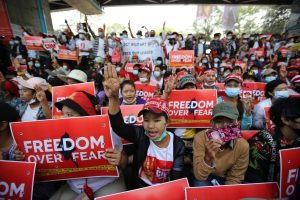Following the February 1, 2021 coup d’état in Myanmar that overthrew the country’s democratically elected government, a shadow parliament and government were established. After eight months of sustained civil disobedience, in September 2021, the National Unity Government (NUG) declared a defensive war, an armed insurrection against the junta. By May 2022, the NUG claimed to control 15 percent of the country, while affiliated ethnic armed organizations (EAOs) controlled approximately 30-35 percent.
But war isn’t cheap, especially without any state sponsors.
While several key EAOs, including the Kachin Independence Organization and the Karen National Union, provided some initial training, a limited amount of arms, and assistance, the NUG’s military campaign against the government has been self-funded. While the NUG government has received limited amounts of foreign assistance for humanitarian needs and has made appeals for international assistance for the basic governance of the regions it does control, it has received no external funding for armed operations. The NUG and its 250 affiliated People’s Defense Forces (PDFs) have used an array of funding mechanisms to support their shadow government operations as well as their armed insurrection.
So how has the NUG funded itself?
In short, the NUG and its parliament, the Committee Representing the Pyidaungsu Hluttaw (Union Parliament), have relied on a range of very clever and sophisticated means that take advantage of their overwhelming legitimacy among the public and their technical prowess. They’ve made funding a patriotic endeavor, and all the while have eschewed the ubiquitous production and trade of illicit narcotics, the traditional source of funding for insurgencies in Myanmar, even at a time when drugs are flooding out of the country in record amounts. The NUG has taken advantage of new technologies and put in place some of the most progressive financial systems in Southeast Asia.
But the bottom line is that the NUG is trying to raise revenue as if they are the proper state they claim to be. They’ve used fundraising as an important means to create a bond between the people and the NUG, while at the same time, delegitimizing the State Administrative Council (SAC), as the junta is known.

































